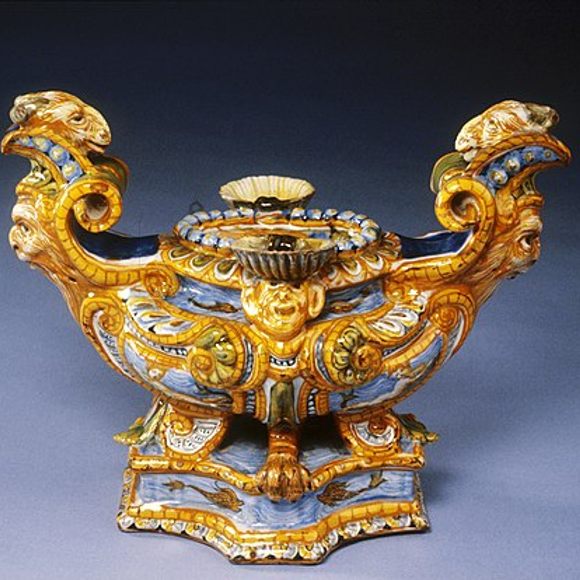In 1378, Charles V faced a dinner dilemma: Should he place the salt in front of himself, the Holy Roman Emperor, or King Wenceslaus of Germany? This seemingly mundane detail had diplomatic repercussions, because the placement of these “salt cellars”—extraordinary containers made to house salt—represented social hierarchy. Charles V opted to place three salt cellars on the table.
Early salt cellars have been traced back as far as Ancient Greece, and their makers have always designed them with an artistry that reflected their social significance . In Ancient Rome, salt sometimes served as payment for soldiers (hence the term “earning his salt”) and represented the settling of an agreement: The absence of a salt cellar on the table was considered uncouth. Later Europeans owned extravagant salt cellars, particularly the French, who shaped them like giant, jeweled ships. (These “nefs” could also hold other spices or be purely decorative.)
Through the Medieval era, salt was highly valued both as a condiment and as a tool for preserving food. But extracting seawater, then evaporating it over a fire, was expensive and laborious. People lucky enough to have salt passed their salt cellars down from generation to generation, often naming them in wills. Salt cellars were placed at the high end of the table, where the lord and master sat, while people at the lower end of the table used small, humble containers.
Whether lordly or humble, though, diners’ use of salt shows how much they valued a now-quotidien ingredient. “The principle standing salt having been placed before the lord, and smaller salts set on other parts of the table, each person helped himself, from the nearest of these receptacles, with his knife, to as much of its contents as he required and placed it on the side of his trencher; into the salt so placed each slice of meat was dipped, and thence conveyed to the mouth,” Sir Charles Jackson, a Welsh businessman and an authority on silver, once wrote.
By contrast, a common 17th century treatise instructed that salt cellars should be “sett in the myddys of the tabull.” These imposing centerpieces were often made of silver and engraved with elaborate designs, such as “The Great Salt” dish that Harvard University was gifted in 1644, which features traces of both a crowned leopard’s head in the bowl and lion passants adorning its feet and each scroll. Some salt cellars even had a lid, or a tiny arm supporting a folded napkin that covered the salt, “not only to preserve cleanliness, but in earlier days to prevent the ready introduction of poison,” as Alice Morse Earle wrote in her book Home Life in Colonial Days.
Colonists brought this tradition to New England, where the salt cellar indicated the household’s hierarchy. If you were seated “above the salt”—meaning near the end of the table with the hosts—you were a guest of honor. Children and undistinguished guests sat on the other side of the table—“below the salt,” if you will.
No word on whether a contemporary slang term for feeling embittered or upset (“salty”) is a holdover from this bygone table-setting tradition, though.
Where to Try It
-
Harvard Art Museums
32 Quincy Street , Cambridge, Massachusetts, 02138, United StatesHome to The Great Salt.
-
Kunsthistorisches Museum
Maria-Theresien-Platz, Vienna, 1010, AustriaLocation of the famous Cellini Salt Cellar.
Written By
 paulamejia
paulamejia
Sources
- www.histarch.illinois.edu/plymouth/folkhouse.htm#Hall
- www.newenglandhistoricalsociety.com/trenchers-seven-strange-facts-dinner-colonial-new-england/
- books.google.com/books?id=qSJMAAAAYAAJ&pg=PA17&lpg=PA17&dq=salt+cellar+colonial+new+england&source=bl&ots=I7kv3w79l7&sig=hdLPykGH92fgW6uUzoob1uywLA0&hl=en&sa=X&ved=0ahUKEwiR16vqz_zVAhWm14MKHVZnASAQ6AEIWjAL#v=onepage&q=salt%20cellar%20colonial%20new%20england&f=false
- www.pilgrimhallmuseum.org/ce_17_century.htm
- www.harvardartmuseums.org/art/232296
- www.amazon.com/Salt-World-History-Mark-Kurlansky/dp/0142001619

















